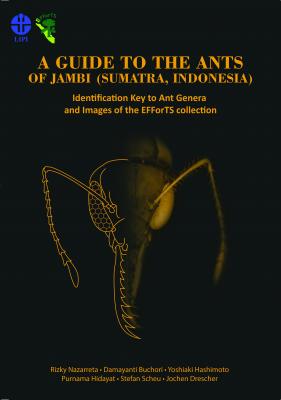A Guide to the Ants of Jambi (Sumatra, Indonesia): Identification Key to Ant Genera and Images of the EFForTS collection
Keywords:
ants, rainforest, sumatraSynopsis
Ants are tiny creatures that are often overlooked in our everyday lives. Yet, there are more than 15.000 species of ants on Earth, and their total biomass is higher than that of all humans combined. They invented agriculture more than 50 million years ago, turn more soil than earthworms, can lift 5,000 times their body weight, and can form supercolonies that span across continents. With the third largest tropical forest in the world, Indonesia is home to thousands of ant species, many of them unknown to science. This book documents more than 300 ant species that were found in rainforests and agroforestry of Jambi Province, Sumatra, and includes a recently updated Identification Key to the ant genera of Southeast Asia. Studying this book will bring you closer to our planet’s fascinating diversity, and the little things that run our world. This book will be a great starting point for those who want to know more about the ants of Southeast Asia, as well as a valuable resource for scientists and
students studying ants this part of the world. All in all, this book is a compendium of the ants of Jambi, Sumatra, and embodies a starting point for further ant research in Indonesia.
Downloads
References
Alpert, G. (2014). Technomyrmex wheeleri [Online image]. AntWiki. https://www.antwiki.org/wiki/Technomyrmex_wheeleri.
AntWeb. (2020, August 5). Country: Indonesia. https://www.antweb.org/country.do?name=Indonesia
Bolton, B. (1994). Identification guide to the ant genera of the world. Harvard University Press.
Borowiec, M. (2013). CASENT0106328 Euprenolepis procera [Online image]. AntWeb. https://www.antweb.org/specimenImages.do?name=casent0106328.
Borowiec, M. (2013). CASENT0106280 Carebara pygmaea [Online image]. AntWeb. https://www.antweb.org/specimenImages.do?name=casent0106280.
Drescher, J., Rembold, K., Allen, K., Beckschäfer, P., Buchori, D., Clough, Y., Faust, H., Fauzi, A.M., Gunawan, D., Hertel, D., Irawan, B., Jaya, I.N.S., Klarner, B., Kleinn, C., Knohl, A., Kotowska, M.M., Krashevska, V., Krishna, V., Leuschner, C., Lorenz, W., Meijide, A., Melati, D., Nomura, M., Pérez-Cruzado, C., Qaim, M., Siregar, I.Z., Steinebach, S., Tjoa, A., Tscharntke, T., Wick, B., Wiegand, K., Kreft, H., & Scheu, S. (2016). Ecological and socio-economic functions across tropical land use systems after rainforest conversion. Philosophical Transactions of the Royal Society B-Biological Sciences, 371(1694). https://doi.org/10.1098/rstb.2015.0275.
Ericson, W. (2012). CASENT0901893 Camponotus festinus [Online image]. AntWeb. https://www.antweb.org/specimenImages.do?name=casent0901893.
Ericson, W. (2013). CASENT0903250 Myrmoteras estrudae [Online image]. AntWeb. https://www.antweb.org/specimenImages.do?name=casent0903250.
Ericson, W. (2013). CASENT0904185 Aphaenogaster feae [Online image]. AntWeb. https://www.antweb.org/specimenImages.do?name=casent0904185.
Ericson, W. (2013). CASENT0905765 Pheidole ghigii [Online image]. AntWeb. https://www.antweb.org/specimenImages.do?name=casent0905765.
Ericson, W. (2013). CASENT0904246 Pheidole huberi [Online image]. AntWeb. https://www.antweb.org/specimenImages.do?name=casent0904246.
Ericson, W. (2013). CASENT0907889 Pheidole huberi [Online image]. AntWeb. https://www.antweb.org/specimenImages.do?name=casent0907889.
Ericson, W. (2013). CASENT0907990 Pheidole rabo [Online image]. AntWeb. https://www.antweb.org/specimenImages.do?name=casent0907990.
Ericson, W. (2013). CASENT0907989 Pheidole rabo [Online image]. AntWeb. https://www.antweb.org/specimenImages.do?name=casent0907989.
Ericson, W. (2013). CASENT0902835 Tetraponera polita [Online image]. AntWeb. https://www.antweb.org/specimenImages.do?name=casent0902835.
Fayle, T. M., Yusah, K. & Hashimoto, Y. (2014). Key to the ant genera of Borneo in English and Malay. Retrieved May 1, 2020, from https://www.tomfayle.com/Ant%20key.htm.
Gouyon, A., de Foresta, H., & Levang, P. (1993). Does ‘jungle rubber’ deserve its name? An analysis of rubber agroforestry systems in Southeast Sumatra. Agroforestry System, 22, 181–206. https://doi.org/10.1007/BF00705233.
Hashimoto, Y. (2003). Identification guide to ant genera of Borneo. In Y. Hashimoto & H. Rahman (Eds.), Inventory & Collection - Total protocol for understanding of biodiversity (pp. 89-162). Institute for Tropical Biology and Conservation, Universiti Malaysia Sabah and Japan International Cooperation Agency (JICA).
Hölldobler, B., & Wilson, E. O. (1990). The ants. Harvard University Press.
Hölldobler, B., & Wilson, E. O. (2009). The superorganism – The beauty, elegance, and strangeness of insect societies. W. W. Norton & Company.
Keller, L., & Gordon, É. (2009). The lives of ants. Oxford University Press.
Lazarus, A. (2013). CASENT0282388 Pheidole aristotelis [Online image]. AntWeb. https://www.antweb.org/specimenImages.do?name=casent0282388.
Lazarus, A. (2013). CASENT0219465 Pheidole aristotelis [Online image]. AntWeb. https://www.antweb.org/specimenImages.do?name=casent0219465.
Lieberman, Z. (2013). CASENT0904268 Pheidole ghigii [Online image]. AntWeb. https://www.antweb.org/specimenImages.do?name=casent0904268.
Lieberman, Z. (2014). CASENT0914657 Recurvidris kemneri [Online image]. AntWeb. https://www.antweb.org/specimenImages.do?name=casent0914657.
Nobile, A. (2008). CASENT0103251 Nylanderia bourbonica [Online image]. AntWeb. https://www.antweb.org/specimenImages.do?name=casent0103251.
Ortega, E. (2012). CASENT0281714 Pheidole plagiaria [Online image]. AntWeb. https://www.antweb.org/specimenImages.do?name=casent0281714.
Ortega, E. (2012). CASENT0281725 Pheidole tjibodana [Online image]. AntWeb. https://www.antweb.org/specimenImages.do?name=casent0281725.
Ortega, E. (2012). CASENT0281684 Pheidole upeneci [Online image]. AntWeb. https://www.antweb.org/specimenImages.do?name=casent0281684.
Ortega, E. (2012). CASENT0281874 Tetraponera nodosa [Online image]. AntWeb. https://www.antweb.org/specimenImages.do?name=casent0281874.
Perry, R. (2012). CASENT0901637 Pheidole jacobsoni [Online image]. AntWeb. https://www.antweb.org/specimenImages.do?name=casent0901637.
Potapov, A., Sandmann, D., & Scheu, S. (2019). Ecotaxonomy virtual research environment – Traits and species. Ecotaxonomy. http://ecotaxonomy.org.
Steiner, F. (2018, June 15). How many ant species are there on earth?. Myrmecological News Blog. https://blog.myrmecologicalnews.org/2018/06/15/how-many-ant-species-are-there-on-earth/.
Tawatao, N. (2010). CASENT0179657 Pheidole submonticola [Online image]. AntWeb. https://www.antweb.org/specimenImages.do?name=casent0179657.
Williams, J. L. (2016). Prenolepis subopaca worker USNMENT00755090 [Online image]. Zenodo. https://zenodo.org/record/182078#.YIIq_OgzbDf.

Downloads
Published
Series
Categories
License

This work is licensed under a Creative Commons Attribution-NonCommercial-ShareAlike 4.0 International License.






























